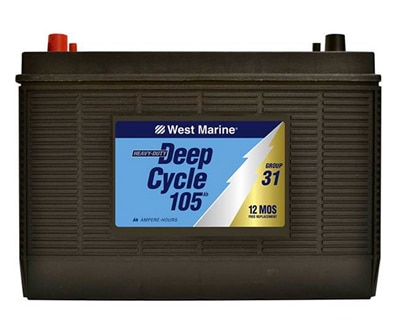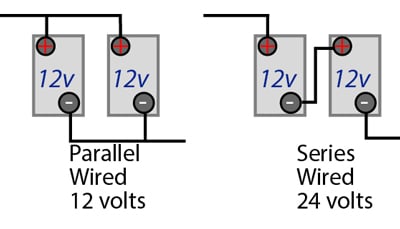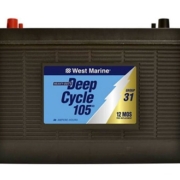Marine Batteries
The source of DC power is usually one or more marine-grade batteries, normally 12 volts each. They are similar to automobile batteries, except sturdier—and of course more expensive.
These powerful DC batteries can be classified into two major categories: Lead Acid and Lithium-Ion
- Lead Acid
- Wet or flooded batteries that contain lead plates in a mixture of distilled water and sulfuric acid. These have been the most common for many years and must be serviced regularly. Unless they are sealed, you will need to inspect the acid levels. If they are low, top up with distilled water or collected rainwater only.
- Batteries containing a gel material, instead of liquid, allow them to be sealed, thus minimal service is required.
- Absorbed glass mat (AGM) that uses micro fiberglass. These represent the latest state of the art in lead acid batteries and are generally more expensive but tend to last the longest.
- Lithium-Ion
- There are various chemical makeups of Lithium-Ion and new ones are being invented daily.
- Lithium-ion batteries are very expensive but tend to last longer
- The energy density per size and weight of Lithium-Ion batteries are multitudes better than Lead-Acid
- Lithium-ion is slowly infusing into the marine market because of its many advantages (except cost (for now))
Since batteries are often networked together, it is suggested that you use only one category type of battery above on your vessel. This will aid in extending the life of your batteries.
All batteries tend to be heavy, so they should be firmly secured low in the vessel, under a settee near the vessel’s center.

DC Battery
Sometimes, in order to double the amount of overall available energy to the boat, two batteries are wired together. If you wire two batteries together, to keep the same voltage (not blow things up) you must do so “in parallel.” This means positive on one battery to positive on the other battery and negative to negative. This keeps the output voltage at 12 volts. Wiring “in series” will result in 24 volts, which will blow up your circuits and bulbs and bilge pumps and who knows what else.

Parallel and Series Wired Batteries.







